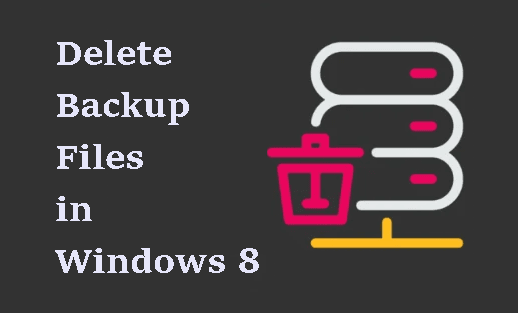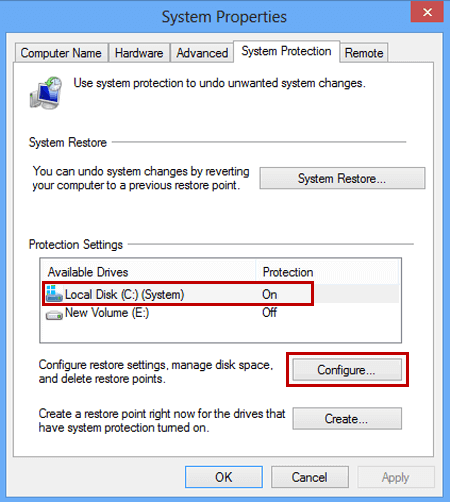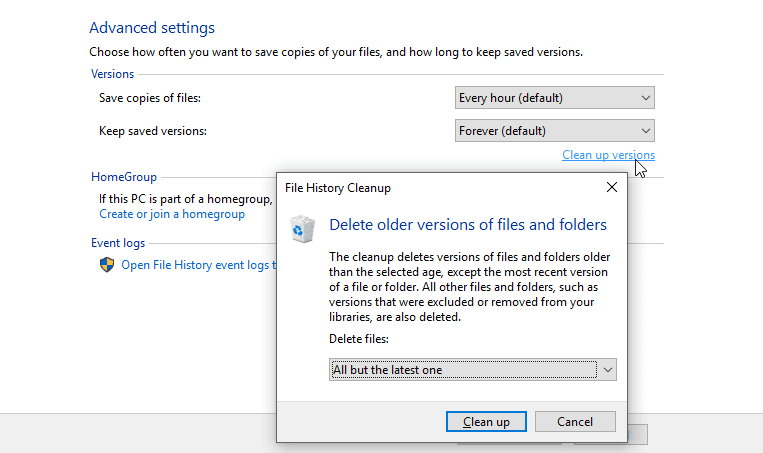How to Delete Backup Files in Windows 8 Automatically
Why Delete Backup Files in Windows 8?
To ensure data safety, most people choose to backup PC data regularly. Both System Restore (Windows 7/8/10/11) and File History (Windows 8/10/11) can help make it. However, as time goes by, there can be lots of backup files occupying your disk space and then there is no space to store a new backup file.
Therefore, it’s necessary to delete old backup files to make enough room for the newly created one, and that’s just the reason you come to this page. To help you out, here we will tell you how to delete backup files in Windows 8. Just keep reading to get the detailed steps.
How to Delete Backup Files in Windows 8 Effortlessly
As mentioned earlier, you can use System Restore and File History to protect system and data on it. Also, it provides you with a way to delete backup files in Windows 8 if your backup disk full.
>> For System Restore feature, it allows you to make a system restore point to backup computer status (like the system files, system settings, and local user profiles). Then, you can restore computer to a previous state when your computer is running into issues.
>> For File History software, it allows you to backup files that are stored in Documents, Music, Pictures, Videos, and Desktop folders as well as the OneDrive files available offline on your PC. So you can restore any file history versions if it's damaged or deleted.
Solution 1. Delete System Restore Points
System Restore create a restore point automaticaly before Windows Update, software installation, etc. Thus, it will occupy much disk space in the long term, to avoid the corresonding error and computer performance, you need to delete all the backup files from time to time.
Step 1. Press Windows key and R key to open Run box > Type control panel and click OK.
Step 2. On Control Panel window: enter restore point in the search bar > choose Create a restore point.
Step 3. On System Properties window: click System Protection > select hard drive that has system protection turned on and click Configure.
Step 4. Click Delete and click Continue on the pop-up window. Then it will start deleting all the restore points on the chosen drive.
When the process is finished, you will see a pop-up window to tell you the restore points have been deleted successfully.
Solution 2. Delete File History Backup Versions
File History can create various backup files especially if you choose to backup your files every hour. So to delete Windows 8 backup files, you can remove the old backup versions by File History Cleanup feature. Below are steps to make it.
Step 1. Open File History from Control Panel > Click Advanced settings.
Step 2. Choose Clean up versions > Choose to delete files and folders older than the selected time > Click Clean up to confirm.
On the many ways to manage disk space:
#1: Change backup frequency. Go back to Advanced settings and then select a longer backup frequency, every 12 hours or daily, for example.
#2: Change saved versions. Similarly, in the Advanced settings, select a shorter backup retention period, such as, keep backup versions 1 month, then it will delete backup files automatically.
Flexible Way to Manage Backup Disk Space in Windows 8
Except for above ways to delete backup files and manage disk space, you can try one more flexible way to backup and remove Windows 8 backup files. It is using third-party backup software integrated with such features. Qiling Disk Master Professional is a good option and you can alleviate the backup disk full in different levels.
- Default level: It will compress or spit backup image automatically to make it smaller. If it is a system or disk backup, it only backs up used sectors of file systems.
- Modern level: If you enable schedule backup, it will backup only changed files with incremental backup. You can also try differential backup and it is safer. Besides, you are able to set high compression and customized splitting.
- High level: It offers you 3 cleanup methods (By quantity, By time, By daily/weekly/monthly), which helps to delete backup images automatically without human intervention. Thus, you will never worry about the trouble of low disk space
To get started, please download the free trial of Qiling Disk Master Professional and follow the steps below to manage your backup files in one flexible way. For sever users, try Qiling Disk Master Server.
Set Backup Task and Schedule Settings for Data Protection
Step 1. Open Qiling Disk Master Professional. Then click Backup and File Backup.
Step 2. Choose the folders or files you want to backup and select the destination path to save the backup image.
Step 3. Click Schedule Backup at the lower location and enable it. You can then select a specific time to run: Daily/Weekly/Monthly or use Event triggers and USB plug in. At the same time, it will backup only changed files with Incremental Backup unless you change it to Differential Backup.
Note: Either Incremental Backup or Differential Backup will help save the disk space.
- Full Backup will save all the data on the selected folders.
- Incremental Backup will take a snapshot only of the changed and added files based on the previous related backup. Thus, it requires one full backup and all the linked backups.
- Differential Backup will backup the changed and added files based on the last full backup. Similarly, it requires one full backup and any differential backup, preferably the latest one.
Set Backup Scheme to manage disk space
Step 1. Fast forward to the window you set a schedule backup, click Backup Scheme next to it and then enable it.
Step 2. Choose one of the backup scheme in the following window, you have 3 options.
By quantity: You can input the number of the backup sets you want to keep and then it will delete old backups after exceeding the specified value. By default, one backup set is 1 full backup and 6 incremental backup or 1 full backup and 6 differential backup if you don't change it.
By time: You can set the number of backups based on daily, weekly or monthly. When it exceeds the number, all the previous backups will be deleted.
By daily/weekly/monthly: You can keep all the backups within several days, and then only keep full backups if the set number of days exceeds, finally when the set number of weekly exceeds, all the backups will be deleted except for one full backup every month .
Step 3. Confirm the backup scheme and click OK and Proceed to backup and remove Windows 8 backup files.
Now Qiling Disk Master Pro will backup your file as the schedule you have set, and will automatically delete the old backup images to free up your disk space and also make sure the backup images are recoverable.
Conclusion
That’s all for how to delete backup files in Windows 8. Besides using the built-in tools to manage your backup files, you can also try Qiling Disk Master Professional to backup and delete backup images in a more flexible way.
And it provides you with different levels, for example, it will automatically compress or split a backup image if create a Windows 8 image backup. Also, you can enjoy intelligent sector backup, incremental or differential backup, automatic backup cleanup, etc. In addition, it also can help you backup computer to USB flash drive to save your disk space.
Related Articles
- How to Delete Backup Files in Windows 10 When Backup Disk Full?
What to do if the backup disk is full? You can try the following methods to delete backup files created by Windows Backup and Restore, File History, etc. to free up disk space. - How to Delete System Restore Points in Windows 7, 8,10, 11
You may want to delete system restore points to free up disk space on your drive. Here you will find a more powerful way to automatically do this work for you. - How to Automatically Delete Backups Older than X Days
How to automatically delete backups older than x days? This guide will tell you 2 ways to make it: Windows built-in tool & Qiling Disk Master. - Create Windows Server 2003 System Restore Point with Alternative Ways
Does Windows Server include restore point featue? How do I create system restore point in Windows Server 2003 (R2)? You could use built-in Backup Utility or Qiling Disk Master.






